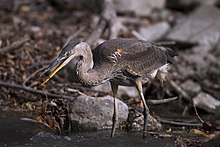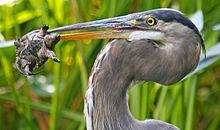Great blue heron
| Great Blue Heron | |
|---|---|

| |
| Scientific classification | |
| Kingdom: | |
| Phylum: | |
| Class: | |
| Order: | |
| Family: | |
| Genus: | |
| Species: | A. herodias
|
| Binomial name | |
| Ardea herodias Linnaeus, 1758
| |

| |
The Great Blue Heron (Ardea herodias) is a large wading bird in the heron family Ardeidae, common near the shores of open water and in wetlands over most of North and Central America as well as the West Indies and the Galápagos Islands. It is a rare vagrant to Europe, with records from Spain, the Azores and England. An all-white Caribbean population was once known as a separate species, the Great White Heron.
Taxonomy
The Great Blue Heron was one of the many species originally described by Carolus Linnaeus in his 18th century work, Systema Naturae.[2]
The Great Blue Heron is replaced in the Old World by the very similar Grey Heron, which differs in being somewhat smaller (90–98 cm), with a pale gray neck and legs, lacking the browner colors that Great Blue Heron has there. It forms a superspecies with this and also with the Cocoi Heron from South America, which differs in having more extensive black on the head, and a white breast and neck.
There are five subspecies:[3]
- Ardea herodias herodias Linnaeus, 1758. Most of North America, except as below.
- Ardea herodias fannini Chapman, 1901. The Pacific Northwest from southern Alaska south to Washington; coastal.
- Ardea herodias wardi Ridgway, 1882. Kansas and Oklahoma to northern Florida.
- Ardea herodias occidentalis Audubon, 1835. Southern Florida, Caribbean islands. Formerly known as a separate species, the Great White Heron.
- Ardea herodias cognata Bangs, 1903. Galápagos Islands.
Description
The largest North American heron, with a head-to-tail length of 91–140 cm (36-55 in), a wingspan of 167-201 cm (66-79 in), and a weight of 2–3.6 kg (4.4-8 lbs), it is blue-gray overall, with black flight feathers, red-brown thighs, and a paired red-brown and black stripe up the flanks; the neck is rusty-gray, with black and white streaking down the front; the head is paler, with a nearly white face, and a pair of black plumes running from just above the eye to the back of the head. The feathers on the lower neck are long and plume-like; it also has plumes on the lower back at the start of the breeding season. The bill is dull yellowish, becoming orange briefly at the start of the breeding season, and the lower legs gray, also becoming orangey at the start of the breeding season. Immature birds are duller in color, with a dull blackish-gray crown, and the flank pattern only weakly defined; they have no plumes, and the bill is dull gray-yellow.[3][4][5]
The heron stride is around 22 cm (9 in), almost in a straight line. Two of the three front toes are generally closer together. In a track the front toes as well as the back often show the small talons.[6]
The subspecies differ only slightly in size and plumage tone, with the exception of subspecies occidentalis, which as well as normal colored birds, also has a distinct white morph, known as the Great White Heron (not to be confused with the Great Egret, for which "Great White Heron" was once a common name). It is found only in south Florida and some parts of the Caribbean. The Great White Heron differs from other Great Blues in bill morphology, head plume length, and in having a total lack of pigment in its plumage. This is mainly found near salt water, and was long thought to be a separate species. Birds intermediate between the normal morph and the white morph are known as Würdemann's Heron; these birds resemble a "normal" Great Blue with a white head.
The theory that Great White Heron may be a separate species from Great Blue Heron has again been given some support by David Sibley.[7]
Voice
The call is a harsh croak. The heron is most vocal during the breeding season, but will call occasionally at any time of the year in territorial disputes or if disturbed.
Similar species
The "Great White Heron" could be confused with Great Egret but is larger, with yellow legs as opposed to the Great Egret's black legs. The Reddish Egret and Little Blue Heron could be mistaken for the Great Blue Heron, but are smaller, and lack white on the head and yellow in the bill. Erroneously, the Great Blue Heron is sometimes referred to as a "crane".
Distribution and habitat
The Great Blue Heron is found throughout most of North America, including Alaska, British Columbia, Ontario, Quebec, New Brunswick and Nova Scotia. The range extends south through Florida, Mexico and the Caribbean to South America. Birds east of the Rocky Mountains in the northern part of their range are migratory and winter in Central America or northern South America. From the southern United States southwards, and on the Pacific coast, they are year-round residents.[3] However their hardiness is such that individuals often remain through cold northern winters, as well.
It can be found in a range of habitats, in fresh and saltwater marshes, mangrove swamps, flooded meadows, lake edges, or shorelines, but always near bodies of water, usually nesting in trees or bushes.
It has been recorded as a vagrant in England,[8] Greenland, Hawaii, and the Azores.[3]
Behaviour
Diet


The primary food for Great Blue Heron is small fish, though it is also known to opportunistically feed on a wide range of shrimps, crabs, aquatic insects, rodents, other small mammals, amphibians, reptiles, and small birds. Herons locate their food by sight and usually swallow it whole. Herons have been known to choke on prey that is too large.[9] It is generally a solitary feeder. Individuals usually forage while standing in water, but will also feed in fields or drop from the air, or a perch, into water. As large wading birds, Great Blue Herons are able to feed in deeper waters, and thus are able to harvest from niche areas not open to most other heron species.
It feeds in shallow water or at the water's edge during both the night and the day, but especially around dawn and dusk. It uses its long legs to wade through shallow water, and spears fish or frogs with its long, sharp bill.
Breeding

This species usually breeds in monospecific colonies, in trees close to lakes or other wetlands; often with other species of herons.
These groups are called heronry (a more specific term than "rookery"). The size of these colonies may be large, ranging between 5–500 nests per colony, with an average of approximately 160 nests per colony.
Great Blue Herons build a bulky stick nest, and the female lays three to six pale blue eggs. One brood is raised each year. If the nest is abandoned or destroyed, the female may lay a replacement clutch. Reproduction is negatively affected by human disturbance, particularly during the beginning of nesting. Repeated human intrusion into nesting areas often results in nest failure, with abandonment of eggs or chicks.
Both parents feed the young at the nest by regurgitating food. Parent birds have been shown to consume up to four times as much food when they are feeding young chicks than when laying or incubating eggs.
Eggs are incubated for approximately 28 days[10] and hatch asynchronously over a period of several days. The first chick to hatch usually becomes more experienced in food handling and aggressive interactions with siblings, and so often grows more quickly than the other chicks. Predators of eggs and nestlings include turkey vultures, several corvids, hawks, bears and raccoons, the latter two also potential predators of adults. Adult herons, due to their size, have few natural predators, but can be taken by bald eagles, great horned owls and, less frequently, red-tailed hawks. When predation on an adult or chick occurs at a breeding colony, the colony can be abandoned by the other birds, but this does not always occur.[11]

In art
John James Audubon illustrates the Great Blue Heron in Birds of America, Second Edition (published, London 1827-38) as Plate 161. The image was engraved and colored by Robert Havell's, London workshops. The original watercolor by Audubon was purchased by the New-York Historical Society where it remains to this day (January 2009).
Gallery
-
In flight
-
Eating a snake
-
Eating a fish
-
In flight
-
Ardea herodias in the Galapagos
-
In a tree
-
Profile
-
At the San Diego Zoo
-
Neck extended
-
A Great Blue Heron at a beach in Tarpon Springs, Florida
-
A rookery may contain up to 500 nests.
-
Three Great Blue Heron chicks with parents in nest
-
Flight is strong, with slow, regular strokes.
-
February river, London, Ontario, resident showing winter hardiness
-
The nest. The chick on the right-hand side is showing his tongue
-
A Great Blue Heron in a marsh at Mason Neck State Park, Virginia, USA
-
tracks in mud, tide rising
-
Two Great Blue Herons in the St-Lawrence River in the Montreal Area: One flying, one standing.
References
- ^ Template:IUCN2008 Database entry includes justification for why this species is of least concern.
- ^ Template:La icon Linnaeus, C (1758). Systema naturae per regna tria naturae, secundum classes, ordines, genera, species, cum characteribus, differentiis, synonymis, locis. Tomus I. Editio decima, reformata. Holmiae. (Laurentii Salvii). p. 105.
- ^ a b c d del Hoyo, J., Elliott, A., & Sargatal, J., eds. (1992). Handbook of the Birds of the World Vol. 1. Lynx Edicions, Barcelona ISBN 84-87334-10-5.
- ^ Sibley, D. (2000). The Sibley Guide to Birds. National Audubon Society ISBN 0-679-45122-6
- ^ Dickinson, M. B. et al., eds. (1999). Field Guide to the Birds of North America. National Geographic ISBN 0-7922-7451-2.
- ^ Murie & Elbroch, Peterson Field Guide to Animal Tracks, pg. 334 (2005)
- ^ Sibley, D. A. "Great White" Heron - not just a colour morph (retrieved 2009-01-24)
- ^ 6. http://www.thesun.co.uk/sol/homepage/news/article567510.ece "Heron in UK, 3K miles off target
- ^ "Hinterland Who's Who - Great Blue Heron". Canadian Wildlife Service. Retrieved 2007-11-23.
- ^ Great Blue Heron
- ^ http://animaldiversity.ummz.umich.edu/site/accounts/information/Ardea_herodias.html
Bibliography
- Stiles and Skutch, A guide to the birds of Costa Rica ISBN 0-8014-9600-4
External links
![]() Media related to Great Blue Heron at Wikimedia Commons
Media related to Great Blue Heron at Wikimedia Commons
- Audubon's Great Blue Heron - Close-ups from Plate 161, Birds of America
- Great Blue Heron Information - USGS Patuxent Bird Identification InfoCenter
- Great Blue Heron Information and Photos - South Dakota Birds and Birding
- Great Blue Heron Species Account - Cornell Lab of Ornithology
- Great Blue - non-scholarly essay on the etymology and history
- Field Guide on Flickr - photo collection by species


























